

Gmail – kostenloser Speicherdienst und E-Mails von Google. FCUP7UPI4PHMZBU.pdf. ESP8266 Wifi Temperature Logger. First Impression on the ESP8266 Serial-to-WiFi Module. Check my new blog post on the ESP8266 Toy Continuing from my previous blog post about Hi-Link HLK-RM04 module, I have finally received the ESP8266 Serial-to-WiFi module that I’ve been waiting for.
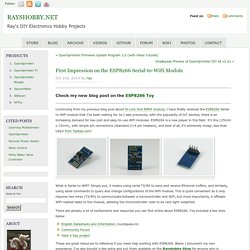
As I said previously, with the popularity of IoT devices, there is an increasing demand for low-cost and easy-to-use WiFi modules. ESP8266 is a new player in this field: it’s tiny (25mm x 15mm), with simple pin connections (standard 2×4 pin headers), and best of all, it’s extremely cheap, less than US$3 from Taobao.com! What is Serial-to-WiFi? Simply put, it means using serial TX/RX to send and receive Ethernet buffers, and similarly, using serial commands to query and change configurations of the WiFi module. There are already a lot of excitements and resources you can find online about ESP8266. PlanetArduino. Despite a wealth of tutorials for setting up and writing code for the ESP8266 WiFi module, there has not been much of anything on programming this cheap wireless module with the Arduino IDE.
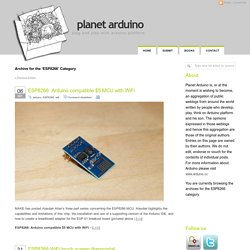
Finally, this has changed. After many months of coding, the Arduino IDE supports the ESP8266 module. The Arduino IDE support was announced on the ESP8266 community forum. Setup is fairly simple with downloads for Linux, OS X, and Windows. This isn’t an ESP8266 shield, either: you can write code for the ESP module, connect the serial pins, and hit the program button. The basic functions of the Arduino IDE – pinMode, digitalRead, digitalWrite, and analogRead – are available. There are a few things that aren’t written yet; PWM doesn’t work, as the ESP8266 only has one hardware PWM source. Filed under: Arduino Hacks, wireless hacks. Getting Started with ESP8266 – Seeed Studio Blog. Overview ESP8266 is a highly integrated chip designed for the needs of a new connected world.
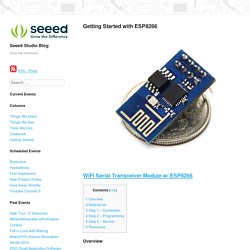
It offers a complete and self-contained Wi-Fi networking solution, allowing it to either host the application or to offload all Wi-Fi networking functions from another application processor. ESP8266 has powerful on-board processing and storage capabilities that allow it to be integrated with the sensors and other application specific devices through its GPIOs with minimal development up-front and minimal loading during runtime.
Its high degree of on-chip integration allows for minimal external circuitry, and the entire solution, including front-end module, is designed to occupy minimal PCB area. ESP8266 weather display. ESP8266 Wifi Temperature Logger. Hacklet 25 – ESP8266 WiFi Module Projects. Compiling Your Own Programs For The ESP8266. When the ESP8266 was first announced to the world, we were shocked that someone was able to make a cheap, accessible UART to WiFi bridge.
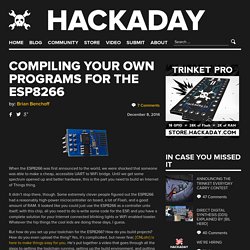
Until we get some spectrum opened up and better hardware, this is the part you need to build an Internet of Things thing. It didn’t stop there, though. Some extremely clever people figured out the ESP8266 had a reasonably high-power microcontroller on board, a lot of Flash, and a good amount of RAM. It looked like you could just use the ESP8266 as a controller unto itself; with this chip, all you need to do is write some code for the ESP, and you have a complete solution for your Internet connected blinking lights or WiFi enabled toaster. Whatever the hip things the cool kids are doing these days, I guess.
But how do you set up your toolchain for the ESP8266? The tutorial covers setting up the Xtensa toolchain and a patched version of GCC, GDB, and binutils. ESP8266 Community Forum. 5$ Arduino WiFi Module!? ESP8266 mini Tutorial/Review. How to use ESP8266 ESP-01 as a SENSOR web client. I’m not going to explain in detail what is ESP8266 because if you have found this post I’m sure you already know it.
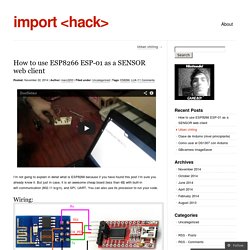
But just in case, it is an awesome cheap board (less than 4$) with built-in wifi communication (802.11 b/g/n), and SPI, UART. You can also use its processor to run your code. Wiring: Use FTDI with 3V3 output. If you face problems with this running on Windows check this link: Unbrick FTDI 232R Burning LuaFirmware Download Coolterm (putty like app but much cooler) Check that your ESP8266 has some firmware through coolterm Enter with coolterm at 115200 (most probable default speed) Once in, type AT+GMR, my firmware was based on 00160901 Congrats, you’ve got a working ESP8266 with a espressif firmware in it.
View topic - Introducing esp-httpd: webserver on an ESP8266. Hi all, One of the things the ESP8266 is ideal for is the whole IoT thing.
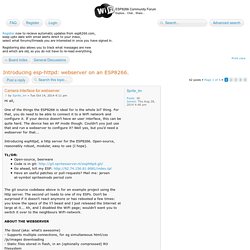
For that, you do need to be able to connect it to a WiFi network and configure it. If your device doesn't have an user interface, this can be quite hard. The device has an AP mode though. Couldn't you just use that and run a webserver to configure it? Introducing esphttpd, a http server for the ESP8266. ESP8266 powered web server + LED control + DHT22 temperature/humidity sensor reading. The ESP8266 System-on-chip (SoC) has recently came out of nowhere and has been taking by storm the IoT DIY world.
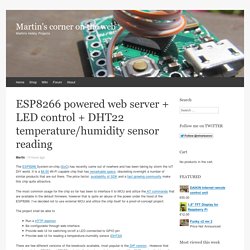
It is a $4.50 Wi-Fi capable chip that has remarkable specs, obsoleting overnight a number of similar products that are out there. The price factor, availability of SDK and a fast growing community make this chip quite attractive. The most common usage for the chip so far has been to interface it to MCU and utilize the AT commands that are available in the default firmware, however that is quite an abuse of the power under the hood of the ESP8266.
I’ve decided not to use external MCU and utilize the chip itself for a proof-of-concept project: The project shall be able to There are few different versions of the breakouts available, most popular is the DIP version . The capacitor is to provide extra juice during active WiFi operations as the FTDI cable can only provide ~50mA while bursts of Wifi may be in the area of ~200mA. 1. For normal start CH_PD to VCC and GPIO15 to GND. ESP8266.